
Oil prices on Friday stayed near three-year highs reached earlier this week, with ongoing OPEC-led supply cuts and strong demand gradually drawing down excess supplies.
Brent crude oil futures LCOc1 were at $73.74 per barrel at 0657 GMT, down 4 cents from their last close.
U.S. West Texas Intermediate (WTI) crude futures CLc1 were down 13 cents at $68.16 a barrel.
Both Brent and WTI hit their highest levels since November, 2014 on Thursday, at $74.75 and $69.56 per barrel respectively. WTI is set for its second weekly gain, climbing more than 1 percent this week, while Brent is also poised to rise for a second week, adding around 1.5 percent.
Traders said there had been some profit-taking on Friday following Thursday’s multi-year highs.
There was also some caution after Russia’s energy minister Alexander Novak was reported saying that a group of producers around the Organization of the Petroleum Exporting Countries (OPEC) as well as Russia may this year ease output restrictions.
Producer cartel OPEC and its allies have been withholding production since 2017, helping push up prices. The deal to cut is currently scheduled to expire at the end of 2018.
After a tepid start in 2017, the supply restraint had by this year started tightening markets.
“Commercial inventories in the OECD are now essentially at their five-year average, and drawdowns likely accelerate as refineries emerge from maintenance ahead of peak seasonal demand,” U.S. investment bank Jefferies said on Friday.
“OECD commercial inventories could fall back to … a level not seen since the oil price collapse that began in 3Q14. On a day of forward demand basis, we believe cover could drop below 57 days later this year, a level last seen in 2011,” it added.
The tightness is also a result of strong oil demand.
“Global oil demand data so far in 2018 has come in line with our optimistic expectations, with 1Q18 likely to post the strongest year-on-year growth since 4Q10 at 2.55 million barrels per day,” U.S. bank Goldman Sachs said in a note published late on Thursday.
Beyond OPEC’s supply management, crude prices have also been supported by an expectation that the United States will re-introduce sanctions on OPEC-member Iran.
“The first key geopolitical issue is the expiration of the current U.S. waiver of key sanctions against Iran,” said Standard Chartered Bank in a note this week, referring to a deadline on May 12 when U.S. President Donald Trump will decide whether or not to re-impose sanctions.
One factor that could start weighing on oil prices is rising U.S. production C-OUT-T-EIA, which has jumped by a quarter since the middle of 2016 to 10.54 million barrels per day (bpd), making the United States the world’s second-biggest producer of crude oil behind only Russia, which pumps almost 11 million bpd.



































